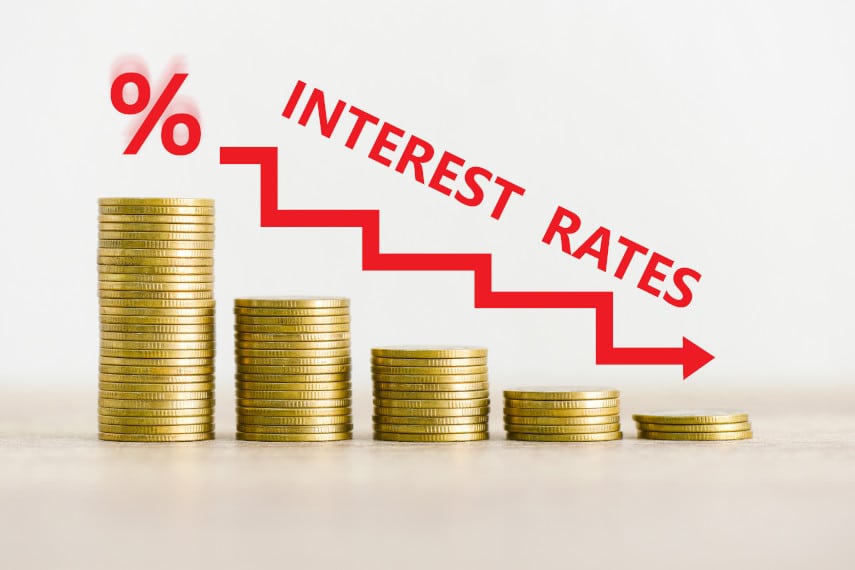
After this week’s inflation report, the stage seems to be set for the Federal Reserve to cut interest rates at next week’s Federal Open Market Committee (FOMC) meeting. But the one big question everyone has is, will the Fed cut interest rates by 25 basis points (0.25%) or 50 basis points (0.50%)?
There are some advantages and drawbacks to each approach, and the Fed has to toe a fine line, lest it cause markets to panic. But what are the chances that the Fed jumps in with a big cut next week?
The Case for 25 Basis Points
The case for a 25 basis point cut boils down to three major points:
- Don’t Spook Markets
- Wait and See
- Don’t Do Too Much Before the Election
Don’t Spook Markets
While labor markets are weakening, a 50 basis point cut might be seen as an indicator that the economy is in worse shape than most people think, and thus is in need of greater stimulus. And that could scare Wall Street.
The last thing the Fed wants to do is to spook markets and spur a huge selloff. Since most people are expecting a 25 basis point cut, doing that wouldn’t ruffle any feathers.
Wait and See
While inflation is down to 2.5% year on year, core inflation is still at 3.2% year on year. With core inflation still somewhat elevated, the Fed may want to wait and see what impact its initial rate cuts have.
A rate cut that’s too big could boost inflation, necessitating either a mid-cycle pause or hike, something the Fed wouldn’t want to do. So a 25 basis point cut is seen as a good first step until the Fed has a better idea which way the economy and inflation are going.
Don’t Do Too Much Before the Election
The Fed also has to deal with the fact that the presidential election is coming up in November and the Fed doesn’t want to be seen as trying to influence the election.
A 50 basis point cut might be seen as an attempt to goose the economy right before the election, and could damage the Fed’s reputation and credibility. A 25 basis point cut is the safer choice, as it’s already expected, and won’t be seen as trying to hand the election to Harris.
The Case for 50 Basis Points
The case for a 50 basis point cut also has three major bases of support.
- Historical Precedent
- Get Ahead of the Curve
- Markets Have Already Priced in Cuts
Historical Precedent
The last time the Fed began a rate tightening cycle like this, in September 2007, it started off with a 50 basis point cut, before transitioning to 25 basis point cuts at subsequent FOMC meetings.
So a 50 basis point cut wouldn’t necessarily signal that things are getting bad, merely that the Fed is starting off a rate cut cycle that it intends to see through, rather than an intra-cycle adjustment period.
Get Ahead of the Curve
The Fed was castigated for its failure to respond to inflation, and rightly so. First the Fed tried to tell us there would be no inflation, then it tried to say that inflation would only be transitory, then it tried to tell us that it could manage it.
None of those were true, and the resulting inflation ended up being the highest in over 40 years. The Fed was behind the curve the entire time.
Does the Fed want to remain behind the curve when it comes to its rate cutting cycle as well?
Some Fed officials are already questioning if smaller rate cuts might not respond to falling inflation fast enough. If the Fed isn’t aggressive enough in its cuts, the fear is that inflation could fall to under 2% before the Fed gets interest rates to where it wants them to be, which could spur larger rate cuts later.
Markets Have Already Priced in Cuts
Since the beginning of July, yields on 1-, 2-, 3-, 4-, and 6-month T-Bills have fallen 27, 29, 37, 46, and 65 basis points respectively. That means that markets have more than priced in a 25 basis point cut already.
If the Fed wants to actually influence interest rates and markets, a 25 basis point rate cut won’t do much, because that cut has already been priced in. But a 50 basis point cut could certainly push interest rates down further.
Does the Fed want to rely on its forward guidance to allow markets to anticipate Fed actions and price them in ahead of time? Or does it want to be a market maker and have its policy actions actually influence markets and interest rates?
For those who don’t want the Fed to remain at the mercy of markets, and who want the Fed to stay ahead of the game, a 50 basis point cut is necessary to ensure that the Fed retains its credibility.
What the Fed Will Do, and How You Might React
With core inflation remaining elevated and higher than expected, there’s almost no chance that the Fed will cut by 50 basis points. So expect a 25 basis point cut and no more next week.
But given the fact that the labor market continues to weaken, further cuts can be expected at the next two meetings. Markets have already priced in at least 1-2 more cuts before the end of the year.
We could be at the beginning of a major rate cut cycle, like the Fed’s 2007-08 rate cut cycle, which saw rates fall from 5.25% to near zero. And if that’s the case, you can kiss current interest rates on savings accounts and money market accounts goodbye.
Many Americans have been content to park their money in accounts earning 5%+ interest rates, but that could all be coming to an end. So the question they have now is, where can they put their money where it will be relatively safe?
As everyone knows, there’s no such thing as a risk-free investment. But there are some assets that are considered safe havens, ports in a storm, that can help safeguard wealth when times get tough.
Gold is one of those, and its reputation as a safe haven asset, an inflation hedge, and a store of value is longstanding. There’s a reason that so many people rush to buy gold when recession or financial crisis threatens.
Now is one of those times, and safe haven buying has helped push gold to all-time high prices in recent weeks. If the US economy continues down the path to recession, gold could push even higher.
Whether you want to purchase gold coins to store at home just in case, or protect your retirement savings with a gold IRA, now is the time to start thinking about where gold fits into your financial planning.
Goldco has worked hard over the years to become one of the best gold companies in the country, with more than $2.5 billion in precious metals placements and over 6,000 5-star reviews from our satisfied customers.
If you’re looking to help preserve your financial well-being with gold, call Goldco today to learn more about why so many Americans are putting their trust in gold.





